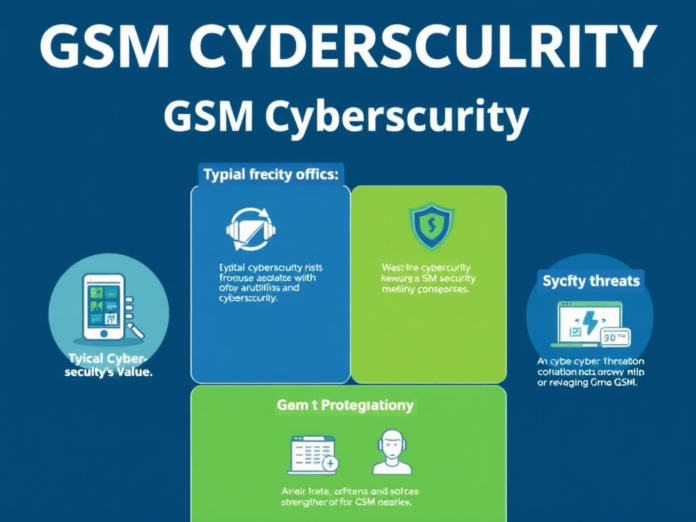Introduction:
Mobile communication has become an essential part of everyday life in the digital age. GSM (Global System for Mobile Communications) networks provide the modern mobile experience from making calls to sending messages, accessing the internet, and even online banking. But mobile networks are increasingly under more sophisticated cybersecurity attacks as they evolve. This paper will examine what GSM cybersecurity is, why it matters, potential hazards, and ways to protect your mobile network.

GSM Cybersecurity is…
GSM cybersecurity is the collection of security policies and technologies designed to protect the GSM network from attacks and vulnerabilities. GSM is among the most widely used mobile communication technologies worldwide. Maintaining privacy, protecting data, and preventing unauthorised access depend on the security of GSM networks, which are linked to billions of people. In the context of GSM, cybersecurity primarily refers to protecting the communication infrastructure, including mobile devices, network components, and the data flowing over the system. Ensuring the security of mobile networks becomes a top priority as they are increasingly relied upon for personal, professional, and financial activities.
GSM Cybersecurity’s Value
There are several reasons why GSM cybersecurity is really vital.
1. Personal Data Protection
Today’s mobile devices save vast quantities of personal data, including contacts, financial information, and private messages. GSM cybersecurity flaws could give hostile individuals access to private data, enabling identity theft, financial fraud, and privacy infringements.
2. Integrity of the Network
Mobile operators depend on safe GSM networks to deliver continuous services. A network’s security breach could interfere with services, resulting in communication problems, data loss, and possibly service interruptions.
3. Preventing Unauthorised Access
Cybercriminals could try to eavesdrop on GSM networks and mobile device communication. Insufficient security would allow attackers to obtain phone data, location information, and other confidential information without permission, endangering both people and companies.
Typical Cybersecurity Risks in GSM Networks
Like any other communication system, the GSM network is vulnerable to particular security concerns. Among the most prevalent cybersecurity risks are:
1. Attacks Man-in-the-Middle (MITM)
A MITM attack involves an attacker intercepting communication between two people, such as between a mobile device and the network. This lets the attacker change communications without either side knowing, steal sensitive information, and eavesdrop on talks.
2. Cloning a SIM card
SIM card cloning is the process by which an assailant duplicates a victim’s SIM card. Doing so allows them to make calls, send texts, and access cell service. SIM card cloning can seriously compromise mobile security, particularly if the device contains banking data or personal information.
3. Listening in
Eavesdropping is the act of listening in on mobile communications, including voice calls, text messages, and internet traffic. Lack of appropriate encryption allows hackers to track communications and steal private information.
4. Spoofing the Network
Network spoofing occurs when a hacker impersonates a legitimate network, deceiving mobile devices into connecting to it. Once linked, the hacker can track and control the traffic, allowing them to steal data or exploit the network.
5. Smishing: SMS Phishing
Smishing, also known as SMS phishing, is the practice of sending fake SMS messages to mobile users. Links or attachments in the mail could, when clicked, damage the user’s device by installing harmful software or collecting personal information.
GSM Cybersecurity Threats in Modern Society
The hazards related to GSM cybersecurity have increased with the arrival of 5 G. Using modern technologies to exploit weaknesses in GSM infrastructure, hackers are becoming increasingly sophisticated. Furthermore, the growing interconnection of gadgets via Iot (Internet of Things) has generated fresh attack routes that GSM networks could exploit. The following elements add to the increasing concerns in GSM cybersecurity:
1. Absence of End-to-End Encryption
Many GSM networks lack adequate encryption for data in transit, which helps attackers to capture and read sensitive information. No end-to-end encryption leaves users vulnerable to many risks, including eavesdropping and man-in-the-middle (MITM) attacks.
2. Insecure Authentication Techniques
Protecting GSM networks from illegal access depends much on authentication. Weak authentication techniques, such as using readily guessed PIN codes or inadequate user verification, make it easier for attackers to take control of mobile accounts and services.
3. Outdated Software
Mobile devices and network infrastructure often run outdated software with potential security flaws. GSM networks remain vulnerable to cyberattacks without consistent updates, which enables hacker exploitation.
4. User Ignorance
Many mobile users are unaware of the dangers associated with GSM networks and how to protect themselves. Lack of knowledge often makes people vulnerable to phishing scams, malware, and other cybersecurity threats.
Ways to Strengthen GSM Cybersecurity
Securing GSM network calls requires a multi-layered approach that combines technology solutions, industry standards, and user education. Some techniques to improve GSM cybersecurity are listed below:
1. Put in Place End-to-End Encryption
Mobile network operators should use end-to-end encryption for all communication to protect data from eavesdropping and man-in-the-middle (MITM) attacks. This ensures that data remains encrypted during transmission and is only decoded by the intended recipient.
2. Enhance Authentication Systems
To stop illegal access, mobile operators should use more robust authentication techniques. User accounts can be further secured with two-factor authentication (2fa), biometrics, and sophisticated PIN codes.
3. Consistent Security Audits and Updates
Device makers and mobile carriers should conduct regular security audits and ensure timely software updates to address known vulnerabilities. Maintaining strong cybersecurity depends on keeping network components and mobile devices up to date.
4. Inform Users About Security Threats
Preventing attacks like phishing and SIM card cloning depends on user knowledge. Improving GSM security can be significantly helped by teaching users about the dangers and motivating them to follow safe practices, including avoiding suspicious links and using strong passwords.
5. Watch for Suspicious Activity in Network Traffic
Monitoring network traffic for unusual behaviour regularly can help find and stop possible cyberattacks before they cause damage. Real-time risk mitigation and detection of illegal access can be accomplished with intrusion detection systems (IDS).
GSM Cybersecurity’s Future
Cybercriminals’ techniques for hacking GSM networks will change as mobile technology evolves. The need for safe mobile networks will rise with 5G and beyond. Governments, mobile operators, and consumers have to work together to improve cybersecurity policies and maintain the integrity of GSM networks. Advancements in artificial intelligence (AI) and machine learning (ML) could become crucial in future real-time threat detection and mitigation. The integration of AI-driven security technologies could improve pattern recognition and cyberattack prediction, providing more proactive protection strategies.
READ MORE – What Makes Iowa Best for Cybersecurity?
FAQs:
1. What is GSM cybersecurity?
GSM cybersecurity is the set of security policies designed to protect the GSM network from data breaches, unauthorised access, and cyberattacks. It includes protecting communication, network components, and mobile devices.
2. What typical dangers to GSM networks are there?
Common dangers include MITM attacks, SIM card cloning, eavesdropping, network spoofing, and SMS phishing (also known as smishing).
3. What can I do to shield my mobile device from GSM security risks?
Use strong passwords, activate two-factor authentication, avoid suspicious links, and ensure your device is running the latest security patches to keep it secure.
4. Why is end-to-end encryption crucial in GSM networks?
End-to-end encryption ensures that data remains safe throughout transmission and can only be decoded by the intended receiver, thereby eliminating eavesdropping and man-in-the-middle (MITM) attacks.
5. How can mobile operators strengthen GSM security?
Strong encryption, frequent software updates, and user education on security concerns help mobile operators improve security.
Conclusion:
The key component of the mobile communication ecosystem is GSM cybersecurity. Mobile networks are constantly evolving; therefore, it is crucial to address the growing cybersecurity concerns that threaten network security, data integrity, and personal privacy. A safer GSM network that shields users from cyber dangers can be created by using robust encryption, enhancing authentication techniques, and informing consumers.



